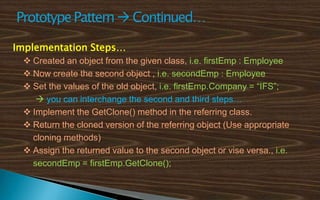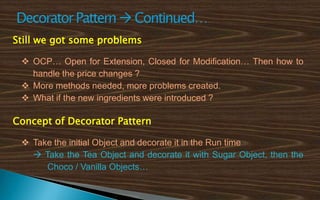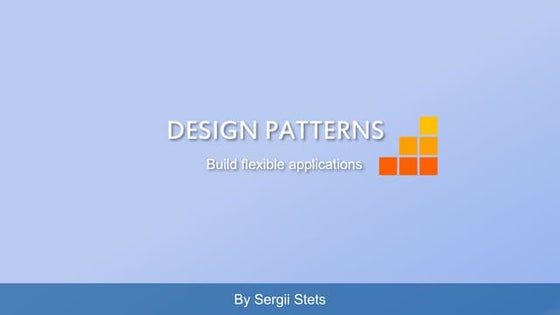Introduction to Design Patterns
- 1. The way how Experts do thingsŌĆ” Prepared & Presented by :- Prageeth Sandakalum, Microsoft Student Champ, Faculty of IT, University of Moratuwa.
- 2. What are Design Patterns ’üČ Development Issues and introduction of Design Patterns ’üČ A brief history on design patters ’üČ What are design patterns? ’üČ Types of Design Patterns ’üČ Has your code been improved ? Implementing Design Patterns in C# ’üČ Singleton Pattern ’üČ Prototype Pattern ’üČ Fa├¦ade Pattern ’üČ Decorator pattern
- 3. What are Design Patterns ? Lets begin with itŌĆ”
- 4. ’üČ ŌĆ£Designing object-oriented software is hard and designing reusable object-oriented software is even harder.ŌĆØ ŌĆō Erich Gamma - ’üČ Dependency Handling - Open and Close methodŌĆ” ’āĀOpen for Extension and Closed for Modification ’üČ Immobility of the existing libraries. ’üČ Knowledge of the patterns that have worked in the past, makes the developers lives much easier in designing newer systems.
- 5. ’üČ1987 - Cunningham and Beck used AlexanderŌĆÖs ideas to develop a small pattern language for Smalltalk ’üČ1990 - The Gang of Four (Gamma, Helm, Johnson and Vlissides) begin work compiling a catalog of design patterns ’üČ1991 - Bruce Anderson gives first Patterns Workshop at OOPSLA ’üČ1993 - Kent Beck and Grady Booch sponsor the first meeting of what is now known as the Hillside Group ’üČ1994 - First Pattern Languages of Programs (PLoP) conference ’üČ1995 - The Gang of Four (GoF) publish the Design Patterns book
- 6. ŌĆ£A design pattern is a general and reusable solution to a commonly occurring problem in software.ŌĆØ - Microsoft Developer Network (MSDN) - ’üČ It is not a code that can be directly use in your application thus We can call a pattern a template to design classes or objects in a way that is proven to be optimized in the past ’üČ Design patterns help to develop the high-level Solutions and to implement the Object Oriented principals ’āĀ Open Close Principal :- Open for extension and closed for modifications ’āĀ Dependency Inversion Principle :- Depend upon Abstractions, Not On concretions.
- 7. OO Design Patterns Creational Structural Behavioral Behavioral Patterns ’üČ Abstract Factory Creates an instance of several families of classes ’üČ Builder Separates object construction from its representation ’üČ Factory Method Creates an instance of several derived classes ’üČ Prototype A fully initialized instance to be copied or cloned ’üČ Singleton A class of which only a single instance can exist
- 8. Structural Patterns ’üČ Adapter Match interfaces of different classes ’üČ Bridge Separates an objectŌĆÖs interface from its implementation ’üČ Composite A tree structure of simple and composite objects ’üČ Decorator Add responsibilities to objects dynamically ’üČ Facade A single class that represents an entire subsystem ’üČ Flyweight A fine-grained instance used for efficient sharing ’üČ Proxy An object representing another object
- 9. Behavioral Patterns ’üČ Chain of Responsibility passing a request between a set of objects ’üČ Command Encapsulate a command request as an object ’üČ Interpreter A way to include language elements in a program ’üČ Iterator Sequentially access the elements of a collection ’üČ Mediator Defines simplified communication between classes ’üČ Memento Capture and restore an object's internal state ’üČ Observer A way of notifying change to a number of classes ’üČ State Alter an object's behavior when its state changes ’üČ Strategy Encapsulates an algorithm inside a class ’üČ Template Method Defer the steps of an algorithm to a subclass ’üČ Visitor Defines a new operation to a class without change
- 10. These are some of the Common advantages in Design patterns. ’üČ Capture expertise and make it more accessible to non-experts in a standard form ’üČ Facilitate communication among the developers by providing a common language ’üČ Make it easier to reuse successful designs and avoid alternatives that diminish reusability ’üČ Facilitate design modifications ’üČ Improve design documentation ’üČ Improve design understandability
- 11. Design Pattern..!! Easier said than done hah? Implementing Design Patterns How to make better codesŌĆ”
- 12. ŌŚ” Concept ’é¢ Ensures that a particular class has only one object ’é¢ provide a central access point to invoke that object ŌŚ” Motivation and Problem addresses ’é¢ Make sure that the client is not allowed to create additional objects ’é¢ ’āĀ The ŌĆ£UserŌĆØ Object UML Class ’é¢ Try out Microsoft Windows basic applications Diagram ’é¢ ’āĀ The Calculator and the Run window
- 13. Implementation StepsŌĆ” ’üČ Create the class with public modifier ’üČ Make the constructor privateŌĆ” So that no body outside, can create objects ’üČ Define a static method GetInstance() to retrieve the Object ’üČ Inside the method, use conditional statements to check whether the object exists ’üČ If not create an object and return it ’üČ Otherwise just return the object ’üČ Then instantiate the object (make it static)
- 14. Some hints for advanced development ’üČ Make the GetInstance() method thread safe ’āĀ Use locks, Double check the instances ’é¦ Create a ŌĆ£readonlyŌĆØ object to use as the locking variable ’üČ Initialize the object on 1st declaration ’āĀ private static Singleton instance=new Singleton(); ’üČ Avoid sub-classing by using sealed class ’āĀpublic sealed class Singleton
- 15. ŌŚ” Concept ’é¢ Avoid repeatedly assigning same value to the similar objects. ’é¢ Allow independent behavior after the cloning ??? ŌŚ” Motivation and Problem addresses ’é¢ When creating objects (i.e. employee), we need to specify the same value repeatedly for objects ’é¢ employeeObj1.CompanyName = ŌĆ£IFSŌĆØ; ’é¢ employeeObj1.CompanyPhone = ŌĆ£011-2845564ŌĆØ; ’é¢ EmployeeObj2.CompanyName = ŌĆ£IFSŌĆØ; ’é¢ employeeObj2.CompanyPhone = ŌĆ£011-2845564ŌĆØ;
- 16. Implementation StepsŌĆ” ’üČ Created an object from the given class, i.e. firstEmp : Employee ’üČ Now create the second object , i.e. secondEmp : Employee ’üČ Set the values of the old object, i.e. firstEmp.Company = ŌĆ£IFSŌĆØ; ’āĀ you can interchange the second and third stepsŌĆ” ’üČ Implement the GetClone() method in the referring class. ’üČ Return the cloned version of the referring object (Use appropriate cloning methods) ’üČ Assign the returned value to the second object or vise versa., i.e. secondEmp = firstEmp.GetClone();
- 17. ŌŚ” Concept ŌĆó Wrap complicated subsystems with simpler interfaces ŌĆó Delegates client requests to appropriate subsystems ŌŚ” Motivation and Problem addresses ’é¢ The Client code become complicated with so many objects How Fa├¦ade ’é¢ The client need not to know the complex architecture Works of the sub system ’āĀ Banking Applications
- 18. Implementation StepsŌĆ” ’üČ Create the Fa├¦ade class with public modifier ’üČ Define object references of all the types in the sub system ’üČ Initialize all the objects ŌĆ£On DemandŌĆØ ’üČ Create simple methods and handle multiple subsystem methods inside that method ’āĀ Withdraw() in Fa├¦ade class handles DailyWithdrowalLimitExceeded(), GetBalance(), IssueReceipt() etc.. Methods
- 19. Some hints for advanced development ’üČ Encapsulate the subsystem, So that it can only be accessed through Fa├¦ade interface. ’āĀ Use internal modifiers ’üČ Make the Fa├¦ade Object SINGLETON ??? ’āĀ Most of the time only one fa├¦ade object is needed ’üČ Use multiple Sub Systems within the same dll. ’āĀ If the sub system is too complexŌĆ” use multiple facades.
- 22. See the Restaurant Problem explained here ’üČ You create a beverage super class and all the beverages inherit from it ’üČ But it will have too much sub classes implementing the same cost method in the super class. ’āĀ Tea, PlainTea, TeaWithoutSugar, IcedTea, VanilaTea, ChocoTea etc ’üČ But each of them have very little difference on IngredientsŌĆ” ’āĀ Adding Milk, Adding Sugar, Adding Chocolate ’üČ To avoid unwanted sub-classing create methods in the super class for the extra changes ’āĀ AddMilk(), AddSugar(), AddChocolate() ’üČ Has the problem been Solved?
- 23. Still we got some problems ’üČ OCPŌĆ” Open for Extension, Closed for ModificationŌĆ” Then how to handle the price changes ? ’üČ More methods needed, more problems created. ’üČ What if the new ingredients were introduced ? Concept of Decorator Pattern ’üČ Take the initial Object and decorate it in the Run time ’āĀ Take the Tea Object and decorate it with Sugar Object, then the Choco / Vanilla ObjectsŌĆ”
- 24. Implementation StepsŌĆ” ’üČ Create the abstract class for the Main Classes, i.e. class Main ’üČ Create the abstract class for the Decorator Classes extending the above class, i.e. class Decorator : Main ’üČ Create the sub classes of the Main class ’üČ Create the Decorator sub classes and let the Constructor to receive a ŌĆ£MainŌĆØ type object ’üČ Do the operation with the received object ’üČ When ever creating an object in the client code, Use the ŌĆ£MainŌĆØ class as the reference
- 25. Thank You !!! References ’üČ Notes from Aruna Wickrama, Teamwork @ Asharp Power Camp ’üČ Head First Design Patterns By Eric Freeman, Elisabeth Robson, Kathy Sierra, Bert Bates. ’üČ Design Principles and Design Patterns Robert C. Martin ’üČ Software Architecture Interview Questions By Shivprasad Koirala, Sham Sheikh ’üČ Articles from GoF (Gang of Four)









































































